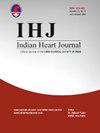左心室射血分数降低患者的旋转粥样斑块切除术短期疗效:一家三级转诊中心的回顾性研究。
IF 1.8
Q3 CARDIAC & CARDIOVASCULAR SYSTEMS
引用次数: 0
摘要
目的:旋转动脉粥样硬化切除术(RA)是一种常用的经皮介入治疗钙化冠状动脉病变的技术,它会产生微碎片,导致下游微血管阻塞、血流缓慢和心肌休克,导致左心室收缩功能障碍患者的不良后果。因此,左室功能障碍被认为是类风湿关节炎的相对禁忌症。我们的目的是评估RA在左室功能障碍患者中的安全性。方法:这是对我们三级转诊中心6年期间(2018年至2023年)所有连续接受RA的患者的回顾性研究。记录了所有的医疗记录、程序细节和住院结果。结果:504例在研究期间发生RA的患者被分为两组:左心室射血分数(LVEF)≤35%(平均29.14±4.95%)的1组(n=209)和LVEF中度降低或保持35%(平均47.86±6.68%)的2组(n=295)。两组患者在基线人口统计学特征、危险因素、血管造影特征、支架长度、造影剂体积和手术时间方面无显著差异。两组住院死亡率无差异(2.3% vs 0.7% p=0.63)。未发现LVEF是类风湿关节炎患者死亡率的独立预测因子。结论:行PCI合并RA患者的住院死亡率不受左室功能障碍的影响。需要更多随访时间更长、样本量更大的研究或纳入本研究的荟萃分析来证实这些结果。本文章由计算机程序翻译,如有差异,请以英文原文为准。
Short-term outcomes of rotational atherectomy in patients with reduced left ventricular ejection fraction: A retrospective review from a tertiary referral centre
Objective
Rotational atherectomy (RA), a commonly used technique for the percutaneous intervention of calcific coronary lesions, produces micro-debris which cause downstream microvascular obstruction, slow flow, and myocardial stunning leading to adverse outcomes in patients with left ventricular (LV) systolic dysfunction. Hence, the presence of LV dysfunction was considered a relative contraindication for RA. We aimed to assess the safety of RA in patients with LV dysfunction.
Method
This is a retrospective review of all consecutive patients who underwent RA at our tertiary referral centre over a 6-year period (2018–2023). All medical records, procedural details, and in-hospital outcomes were recorded. The primary outcome of the study was in-hospital mortality.
Results
504 patients who underwent RA during the study duration were divided into two groups: Group 1 (n = 209) with left ventricular ejection fraction (LVEF) ≤35 % (mean 29.14 ± 4.95 %) and group 2 (n = 295) with moderately reduced or preserved LVEF >35 % (mean 47.86 ± 6.68 %). There was no significant difference in the baseline demographic characteristics, risk factors, angiographic profile, stent length, contrast volume, and procedure time between the two groups. The in-hospital mortality was not different between the two groups (2.3 % vs 0.7 % p = 0.63). LVEF was not found to be an independent predictor of mortality in patients undergoing RA.
Conclusion
The in-hospital mortality of patients undergoing PCI with RA was not affected by the presence of LV dysfunction. Additional studies with a longer follow-up duration and a larger sample or a meta-analysis incorporating our study are needed to confirm these results.
求助全文
通过发布文献求助,成功后即可免费获取论文全文。
去求助
来源期刊

Indian heart journal
CARDIAC & CARDIOVASCULAR SYSTEMS-
CiteScore
2.60
自引率
6.70%
发文量
82
审稿时长
52 days
期刊介绍:
Indian Heart Journal (IHJ) is the official peer-reviewed open access journal of Cardiological Society of India and accepts articles for publication from across the globe. The journal aims to promote high quality research and serve as a platform for dissemination of scientific information in cardiology with particular focus on South Asia. The journal aims to publish cutting edge research in the field of clinical as well as non-clinical cardiology - including cardiovascular medicine and surgery. Some of the topics covered are Heart Failure, Coronary Artery Disease, Hypertension, Interventional Cardiology, Cardiac Surgery, Valvular Heart Disease, Pulmonary Hypertension and Infective Endocarditis. IHJ open access invites original research articles, research briefs, perspective, case reports, case vignette, cardiovascular images, cardiovascular graphics, research letters, correspondence, reader forum, and interesting photographs, for publication. IHJ open access also publishes theme-based special issues and abstracts of papers presented at the annual conference of the Cardiological Society of India.
 求助内容:
求助内容: 应助结果提醒方式:
应助结果提醒方式:


